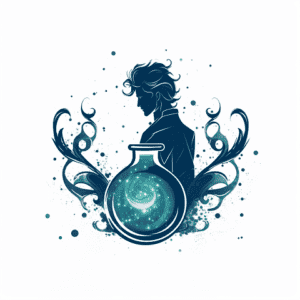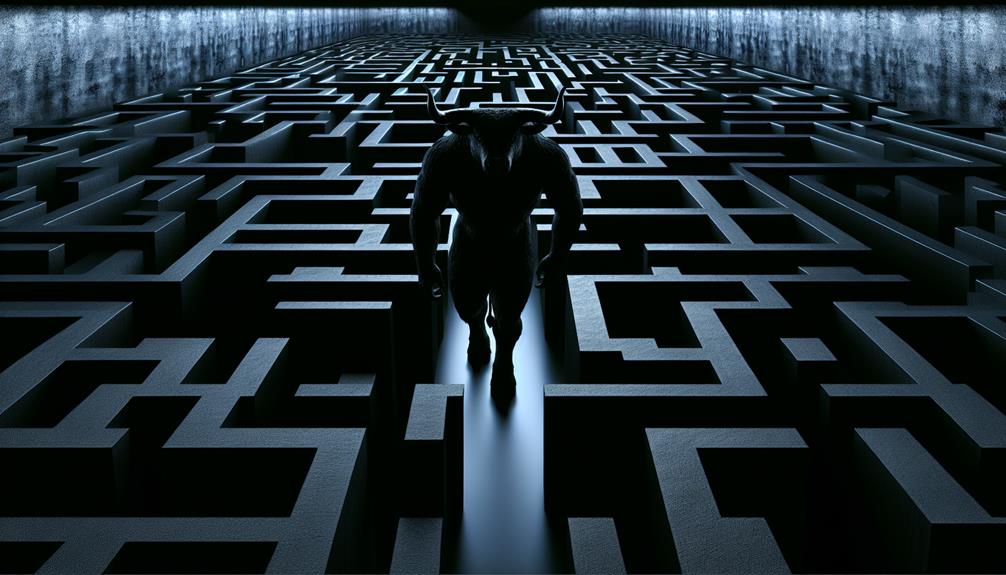Like a labyrinth waiting to be explored, the myth of the Minotaur is a complex and intriguing tale that has captivated audiences for centuries. You may have heard snippets of the story, but there's much more to uncover about this enigmatic figure from Greek mythology. From its origins to its modern-day significance, the Minotaur's tale is one steeped in mystery and symbolism that continues to resonate in contemporary culture. So, why has this myth endured for so long, and what deeper meanings lie within its labyrinthine depths?
The Origins of the Minotaur Myth
The origins of the Minotaur myth can be traced back to ancient Greek mythology and the story of King Minos of Crete. According to the ancient origins, King Minos angered the god Poseidon, who in turn cursed Minos' wife, causing her to fall in love with a bull. This union resulted in the birth of the Minotaur, a creature with the body of a man and the head of a bull. To contain the Minotaur, King Minos commissioned the construction of the labyrinth, a maze designed by the architect Daedalus. This myth has had a significant cultural impact, permeating various forms of art, literature, and popular culture.
The story of the Minotaur has left an indelible mark on culture, inspiring countless retellings and adaptations in art, literature, and film. The intricate labyrinth, the tragic fate of the hero Theseus, and the monstrous Minotaur have all become iconic elements of this ancient tale. The myth's cultural impact is evident in its enduring presence in modern storytelling and its ability to captivate audiences across generations. From ancient Greek pottery to contemporary novels, the Minotaur myth continues to fascinate and resonate with people worldwide.
The Minotaur in Greek Mythology
In Greek mythology, the infamous Minotaur's origin as the offspring of King Minos' wife and a bull remains a source of fascination and intrigue. The Minotaur's appearance was that of a creature with the body of a man and the head of a bull, a terrifying and awe-inspiring sight that struck fear into the hearts of all who beheld it. The labyrinth, designed by the renowned craftsman Daedalus, was the intricate and bewildering maze where the Minotaur was confined. The labyrinth was an architectural marvel, built to imprison the monstrous Minotaur and ensure that it never found its way out to wreak havoc upon the world.
In Greek mythology, the Minotaur was a symbol of primal ferocity, a creature of immense strength and savage nature. Its appearance evoked a sense of dread and awe, embodying the fearsome power of the unknown.
The Minotaur's labyrinth, a winding, perplexing structure, became the setting for the heroic tale of Theseus and the Minotaur. This labyrinth was an inescapable prison, a testament to the power and influence of King Minos, and a fearsome challenge for any who dared to enter its depths.
The Minotaur in Greek mythology was a fearsome creature, both in appearance and the treacherous labyrinth it inhabited. Its presence loomed large in the ancient tales, leaving an indelible mark on the rich tapestry of Greek mythology.
The Minotaur's Significance in Contemporary Culture
Evolving from its ancient roots, the Minotaur continues to captivate and inspire contemporary culture through various artistic, literary, and cinematic expressions. In modern interpretations, the Minotaur often symbolizes the struggle with inner demons, representing the complexities of human nature and the darkness within. This timeless theme has permeated pop culture, leading to the Minotaur's frequent appearances in literature, films, and even video games.
| Modern Interpretations | Pop Culture Representations |
|---|---|
| The Minotaur as a metaphor for | The Minotaur appearing in |
| inner conflict and the human | contemporary literature, |
| psyche in psychological thrillers | films, and graphic novels. |
| Reimagining the Minotaur in | The Minotaur featured in |
| dystopian settings, reflecting | modern art installations, |
| societal anxieties and fears. | fashion designs, and |
| advertising campaigns. |
Contemporary artists have reimagined the Minotaur in thought-provoking ways, using the creature to explore issues of identity, power, and the human condition. In pop culture, the Minotaur has become a recognizable figure, often depicted in visually striking and emotionally evocative ways, resonating with audiences across the globe. Its enduring presence in contemporary culture serves as a testament to the Minotaur's lasting significance and its ability to transcend time, continuing to intrigue and inspire new generations.
Frequently Asked Questions
What Is the Physical Appearance of the Minotaur?
When describing the physical appearance of the Minotaur, consider its mythological origins. The Minotaur is a creature with the body of a human and the head of a bull, typically depicted as powerful and intimidating.
How Did the Ancient Greeks View the Minotaur in Terms of Religion and Worship?
How did the ancient Greeks view mythological creatures in terms of religion and worship? Their beliefs were deeply intertwined with mythical significance and influenced religious practices. Did these creatures inspire fear or devotion?
Are There Any Archaeological Findings Related to the Minotaur Myth?
Have any archaeological findings shed light on the mythological origins and cultural impact of the Minotaur? These findings have historical significance and contribute to our understanding of ancient beliefs and their influence on society.
What Are Some Lesser-Known Adaptations or Interpretations of the Minotaur in Literature and Art?
In modern interpretations and pop culture, artistic representations and fictional adaptations of the Minotaur can be found in various forms of literature and art. These lesser-known depictions offer unique perspectives on the myth.
Are There Any Modern-Day Rituals or Traditions That Involve the Minotaur?
Do modern-day celebrations involve Minotaur symbolism? Folklore interpretations and contemporary rituals often incorporate this mythical creature. Its presence can be seen in various cultural events and traditions, blending ancient mythology with modern customs.
Conclusion
Now that you know about the minotaur, you can appreciate the enduring power of myth and legend in our culture. The minotaur's story, like many others, continues to captivate and inspire us. Just as the minotaur roamed the labyrinth, so too do we navigate the twists and turns of our own lives. The minotaur's tale serves as a reminder that within every maze, there is always hope waiting to be found, like a guiding light in the darkness.

